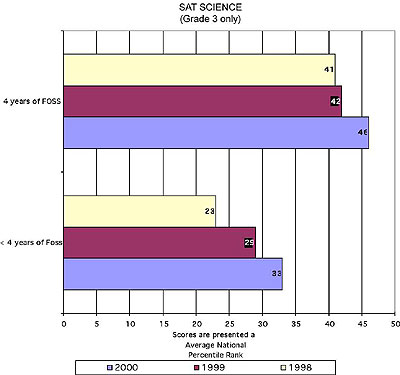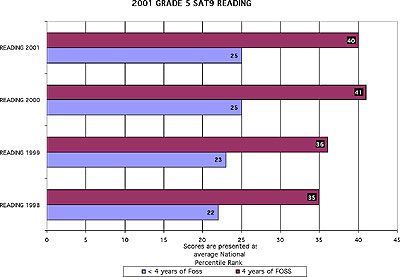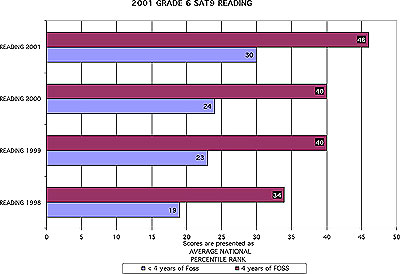

|
|
Resources
Home | Standard Version |
 |
|
|
|
||
| A Preliminary Summary of Findings from a Study of the Effects of Hands-On/Inquiry-Based Instruction on SAT9 Reading Scores |
Since 1995, Fresno Unified has been involved in a comprehensive effort to reform science and mathematics education. This systemic effort developed explicit research designs to collect data on student achievement and other important indicators of instructional efficacy. One of the measures developed was called Science Embedded Assessment System (SEAS), which was included as part of the district adopted science curriculum; Full Option Science System (FOSS). Data from one SEAS assessment each year was collected and scored in a summer scoring institute. Student participation information is can now be analyzed in relation to other measures of student achievement and teacher efficacy. Since the driving force in most schools today is the statewide STAR testing program, relationships between the FOSS curriculum assessment results and SAT9 test results were chosen as a starting point to explore possible effects of the FOSS/SEAS program. Science has been placed at the bottom of the list of priorities for many schools that struggle to raise test scores and improve the reading and literacy skills of a diverse population, 32% of FUSD students are English Learners (EL). Poverty, transiency, and lack of preparation for the school environment (no pre-Kindergarten experiences) make the task seem even more difficult. The intent of this analysis is to explore any effects, perceived or direct, of the FOSS curriculum goal: to develop critical thinking skills, promote literacy and increase science content knowledge, on: reading, comprehension and literacy skills.
While still preliminary, a significant positive relationship has been found between the number of years of FOSS instruction and standardized test scores in Reading. The last year of SEAS scoring occurred in the summer of 2001, but residual effects on both instruction and student achievement may be contributors to continuing trends. By placing elementary students into 2 cohorts: one with 4 years of SEAS scores, and one with at least 1 year, but no more than 3 years of SEAS scores, average Normal Curve Equivalents (NCE's) for the SAT9 were calculated in Science, Reading and Mathematics content areas for the years 1998 through 2001. Mean NCE's were then converted to an average National Percentile Rank to make the scores comparable to state and district reports. Results were calculated by grade level and ethnicity.
The following chart illustrates the relationship between the years of FOSS curriculum on 3rd grade SAT9 Science scores from 1998 to 2001. The students who had received 4 years of FOSS instruction by Spring of 2001 scored higher than the students what had fewer years of FOSS instruction, on the SAT9 Science test.

Since teachers who participated in the FOSS/SEAS program were offered professional development opportunities to enhance science instruction, some effect on Science scores was anticipated. However, the association* of the FOSS program on increased reading scores was not. Approximately 1200 students, who were in grades 5 and 6 at the end of 2000-2001, had received 4 years of FOSS instruction since 1998. These students were identified by having 4-recorded SEAS scores for the years in which assessments were collected and scored. The SAT9 results for Reading for these students as compared to others at their grade level is consistently higher (13-17 points). For instance, over the same time period, 5th grade students with fewer than 4 years of in FUSD scored an average 22 NPR in 1998 and an average 25 NPR in 2001, a growth of 3 NPR’s. 5th graders with 4 years of hands-on, inquiry-based science grew 5 points over the same time period. 6th graders showed a similar growth pattern with a growth difference of 3 points between those having 4 years of SEAS scores and their "less than 4 scores" counterparts.

* Significant at p<. 01

*Significant at p<. 01
When compared to the district, The Foss 4 year cohort of 5th and 6th graders clearly outperforms other groupings of students:
DISTRICT |
4 YEAR COHORT |
<4 YEAR COHORT |
||||
YEAR |
Grade 5 |
Grade 6 |
Grade 5 |
Grade 6 |
Grade 5 |
Grade 6 |
1998 |
24 |
31 |
35 |
34 |
22 |
19 |
1999 |
26 |
33 |
36 |
40 |
23 |
23 |
2000 |
26 |
34 |
41 |
40 |
25 |
24 |
2001 |
27 |
33 |
40 |
46 |
25 |
30 |
Test scores are presented as Average National Percentile Rank
Further study is indicated: Since inquiry-based science promotes the use of critical thinking skills shown to be associated with increased reading comprehension (M. Pressley, 1981), the associations between SAT9 Reading scores and Science instructional strategies would warrant further study. Teachers who use the FOSS science curriculum receive specific professional development in the acquisition and use of inquiry-based strategies hands-on activities, and science embedded literacy. The quality of this professional development is, no doubt a factor in the success of this program. Possible associations and areas of interest might be:
As the state of our educational systems reaches critical stages of accountability, administrators and education professionals are actively searching for ways to improve student achievement. Toward this goal, the focus has been primarily on reading and mathematics. Further study of science embedded literacy and a classroom environment where hands-on science, student inquiry, critical thinking and deep processing of information occur, may provide insight into a more effective way to develop the reading, comprehension and literacy skills needed for higher test scores.
Casteel, C. P., and Isom, B.A. (1994). "Reciprocal Processes in Science and Literacy Learning." TheReading Teacher 47(7): 538-545.
California Department of Education (2000). California Science Content Standards for K-12 Public Schools. Sacramento, CA, California Department of Education.
Diaz, E. (1994). Science Education of Limited English Proficient, English Language Learners. American Educational Research Association, New Orleans, ERIC Document Reproduction Service No. ED376068.
Fradd, S. H., and Lee, O. (1999). "Teacher’s Roles in promoting science inquiry with students from diverse language backgrounds." Educational Researcher 28(6): 14-20.
Holliday, W. G. (1994). "The Reading-Science Learning -Writing Connection: Breakthroughs, Barriers, and Promises." Journal of Research in Science Teaching 31(9): 102-111.
Lee, O., Fradd, S.H., and Sutman, F.X. (1995). "Science Knowledge and Cognitive Strategy Use Among culturally and Linguistically Diverse Students." Journal of Research in Science Teaching 32(8): 797-816.
Lowery, L. (1995), What does research say about the learner?: The biological basis for thinking and learning. The Catalyst, 4, Fall Winter, National Research Council, Washington D.C.
Merino, B.J., and Hammond, L. (1998). Family gardens and solar ovens: Making science education accessible to culturally and linguistically diverse students. Multicultural Education, 5(3), 34-37.
Met, M. (1994). Teaching Content Through a Second Language. Educating Second Language Children: The Whole child, the Whole Curriculum, the Whole Community. F. Genesee. Oakleigh, Cambridge University Press: 159-182.
National Research Council (2000). Inquiry and the National Science Education Standards. Washington, D.C., National Academy Press.
Pressley, M., C. J. Johnson, et al. (1989). "Strategies that Improve Children's Memory and Comprehension of Text." The Elementary School Journal 90(1): 3-32.
Rosebery, A. S., Warren, B., & Conant, F. R. (1990). Cheche Konnen: Appropriating scientific discourse: Findings from language minority classrooms. Cambridge: BBN Labs. (ED 326 058)
Warren, B., and Rosebery, A.S. (1993). Equity in the future tense: Redefining relationships among teachers, students, and science in linguistic minority classrooms (Report No. UD02936). Santa Cruz, CA: National Center for Research on Cultural Diversity and Second Language Learning> (Eric document Reproduction Service No. ED356307).
U.S. Department of Labor, The Secretary’s Commission on Achieving Necessary Skills, (1991). "What work requires of schools: A SCANS report for America 2000." Washington, DC: Author.
BIOS
Jerry D. Valadez is currently the K-12 Science Coordinator with the Fresno Systemic Program. He has participated in several reform efforts including the Urban Systemic Initiative, Project 2061 (AAAS), the California Science Project, and NSTA. In 2000, he was appointed to the Committee on Science Education (COSE) by the National Academy of Sciences. He also serves with the National Science Teachers Association (NSTA) as a member on the Multicultural/Equity Committee, and is chair of the 2002 NSTA panel for the Toyota Tapestry Awards in Literacy and Science. Awards received include the Cal Alive 2001 Educator of the Year award, the National Science Administrator of the Year (2000), the California Science Administrator Supporting Science in 1997, and California Department of Education citations for outstanding contributions to science education in 1994, 1993, and 1987.
Yvonne Freve, is currently a Research Specialist with the Fresno Urban Systemic Program. She has provided technical assistance, database management, and statistical analysis to the USI team from 1995 to 1999, and became an evaluator and research specialist with the Fresno Systemic Program in 1999-2000. Currently she is on-site with the FUSD Science Office working to develop in-depth analyses of student achievement data and instructional strategies. Particular attention is being placed on defining the effective elements of program on closing the achievement gap for linguistic and racial minorities. She has advanced degrees in statistical analysis and research methods from California State University, Fresno.
|
|